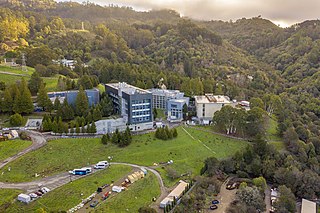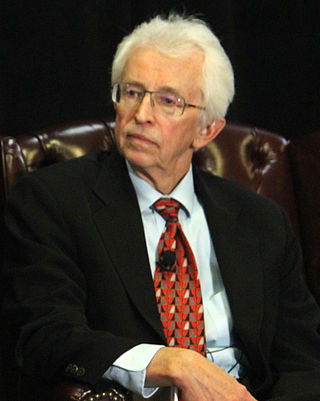Related Research Articles

Los Alamos National Laboratory is one of the sixteen research and development laboratories of the United States Department of Energy (DOE), located a short distance northwest of Santa Fe, New Mexico, in the American southwest. Best known for its central role in helping develop the first atomic bomb, LANL is one of the world's largest and most advanced scientific institutions.
Lawrence Livermore National Laboratory (LLNL) is a federally funded research and development center in Livermore, California, United States. Originally established in 1952, the laboratory now is sponsored by the United States Department of Energy and administered by Lawrence Livermore National Security, LLC.

Lawrence Berkeley National Laboratory (LBNL) is a federally funded research and development center in the hills of Berkeley, California, United States. Established in 1931 by the University of California (UC), the laboratory is sponsored by the United States Department of Energy and administered by the UC system. Ernest Lawrence, who won the Nobel prize for inventing the cyclotron, founded the Lab and served as its Director until his death in 1958. Located in the Berkeley Hills, the lab overlooks the campus of the University of California, Berkeley.

The United States Department of Energy (DOE) is an executive department of the U.S. federal government that oversees U.S. national energy policy and energy production, as well as manages the research and development of nuclear power, the military's nuclear weapons program, nuclear reactor production for the United States Navy, energy-related research, and energy conservation.

The United States Department of Energy National Laboratories and Technology Centers is a system of laboratories overseen by the United States Department of Energy (DOE) for scientific and technological research. The primary mission of the DOE national laboratories is to conduct research and development (R&D) addressing national priorities: energy and climate, the environment, national security, and health. Sixteen of the seventeen DOE national laboratories are federally funded research and development centers administered, managed, operated and staffed by private-sector organizations under management and operating (M&O) contracts with the DOE.

Samuel Wright Bodman III was an American businessman, engineer, and politician who served as the 11th United States Secretary of Energy during the George W. Bush administration, from 2005 to 2009. He was also, at different times, the Deputy Secretary of the Treasury and the Deputy Secretary of Commerce.

The National Energy Technology Laboratory (NETL) is a U.S national laboratory under the Department of Energy Office of Fossil Energy. NETL focuses on applied research for the clean production and use of domestic energy resources. It performs research and development on the supply, efficiency, and environmental constraints of producing and using fossil energy resources while maintaining affordability.

The Spallation Neutron Source (SNS) is an accelerator-based neutron source facility in the U.S. that provides the most intense pulsed neutron beams in the world for scientific research and industrial development. Each year, this facility hosts hundreds of researchers from universities, national laboratories, and industry, who conduct basic and applied research and technology development using neutrons. SNS is part of Oak Ridge National Laboratory, which is managed by UT-Battelle for the United States Department of Energy (DOE). SNS is a DOE Office of Science user facility, and it is open to scientists and researchers from all over the world.

The Joint Genome Institute (JGI) is a scientific user facility for integrative genomic science at Lawrence Berkeley National Laboratory. The mission of the JGI is to advance genomics research in support of the United States Department of Energy's (DOE) missions of energy and the environment. It is one of three national scientific user facilities supported by the Office of Biological and Environmental Research (BER) within the Department of Energy's Office of Research. These BER facilities are part of a more extensive network of 28 national scientific user facilities that operate at the DOE national laboratories.

Siegfried S. Hecker is an American metallurgist and nuclear scientist. He served as Director of the Los Alamos National Laboratory from 1986 to 1997 and is now affiliated with Stanford University, where he is research professor emeritus in the Department of Management Science and Engineering in the School of Engineering, and senior fellow emeritus at the Freeman Spogli Institute for International Studies. During this time, he was also elected a member of the National Academy of Engineering (1988) for outstanding research on plutonium and the forming of materials, and for leadership in developing energy and weapons systems.

John C. Browne is an American physicist.
The Office of Science is a component of the United States Department of Energy (DOE). The Office of Science is the lead federal agency supporting fundamental scientific research for energy and the Nation’
The National Nuclear Security Administration (NNSA) is a United States federal agency responsible for safeguarding national security through the military application of nuclear science. NNSA maintains and enhances the safety, security, and effectiveness of the U.S. nuclear weapons stockpile; works to reduce the global danger from weapons of mass destruction; provides the United States Navy with safe and effective nuclear propulsion; and responds to nuclear and radiological emergencies in the United States and abroad.

The Los Alamos Neutron Science Center (LANSCE), formerly known as the Los Alamos Meson Physics Facility (LAMPF), is one of the world's most powerful linear accelerators. It is located in Los Alamos National Laboratory in New Mexico in Technical Area 53. It was the most powerful linear accelerator in the world when it was opened in June 1972. The technology used in the accelerator was developed under the direction of nuclear physicist Louis Rosen. The facility is capable of accelerating protons up to 800 MeV. Multiple beamlines allow for a variety of experiments to be run at once, and the facility is used for many types of research in materials testing and neutron science. It is also used for medical radioisotope production.
Alvin William Trivelpiece was an American physicist whose varied career included positions as director of the Office of Energy Research of the U.S. Department of Energy (DOE), executive officer of the American Association for the Advancement of Science (AAAS), and director of Oak Ridge National Laboratory (ORNL). He was also a professor of physics and a corporate executive. Trivelpiece's research focused on plasma physics, controlled thermonuclear research, and particle accelerators. He received several patents for accelerators and microwave devices. He died in Rancho Santa Margarita, California in August 2022 at the age of 91.

Edward Moses is an American physicist and is the former president of the Giant Magellan Telescope Organization. He is a past principal associate director for the National Ignition Facility & Photon Science Directorate, where he led the California-based NIF, the largest experimental science facility in the US and the world's most energetic laser, that hopes to demonstrate the first feasible example of usable nuclear fusion.

Athena Safa Sefat, born 1977 in Iran is a Canadian/American physicist, with research focus on quantum materials and correlated phenomena. She was a senior scientist at Oak Ridge National Laboratory and led the DOE Basic Energy Science on "Probing Competing Chemical, Electronic, and Spin Correlations for Quantum Materials Functionality". She is currently a Program Manager at U.S. Department of Energy (DOE), Office of Science, Basic Energy Sciences, with Division of Materials Sciences and Engineering.
Dana Dattelbaum is an American physicist and scientist at Los Alamos National Laboratory. She leads NNSA’s Dynamic Materials Properties portfolio at LANL, which provides experimental data, platforms and diagnostics for materials behaviors relevant to nuclear weapons performance, ranging from plutonium to high explosives.
Ellen K. Cerreta is a materials scientist at Los Alamos National Laboratory, working to provide materials science and technology solutions for national security missions. She is Fellow of ASM International.
Aurora Evelyn Clark is an American computational chemist. She is a professor in the Department of Chemistry at the University of Utah and a Fellow of the American Chemical Society, American Physical Society, and American Association for the Advancement of Science.
References
- 1 2 3 4 Deputy Director Biography, Office of Science, U.S. Department of Energy
- ↑ "DOE Office of Science Shuffles Top-Level Management". www.aip.org. Retrieved 2020-05-21.
- ↑ Appointment of Dr. Harriet Kung as Associate Director of the Office of Science for Basic Energy Sciences, Office of Science, U.S. Department of Energy